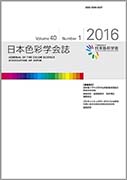
Chanprapha Phuangswan and Mitsuo Ikeda
Journal of the Color Science Association of Japan Vol.40, No.2 pp. 60-66 (2016)
abstract
If there is nothing placed in a space but only a uniform wall without any scratches or patterns one cannot recognize the existence of the space. If any object is inserted there he/she now can recognize the space and understands illumination filling the space although the recognition and the understanding might be slight. The object is called the initial visual information IVI. In a previous paper the recognition of a space between the above IVI and no IVI. The present paper supplements the previous finding by providing observers with still smaller amount of IVI to see whether such smaller IVI gives less recognition of a space and less color constancy. It was found that with only a pair of white petals as the IVI the subject could already notice the existence of a space, understand the illumination in the space, and get the color constancy although very imperfect. The quantitative definition of IVI was proposed by the amount of whiteness which defines the degree of the color constancy.
